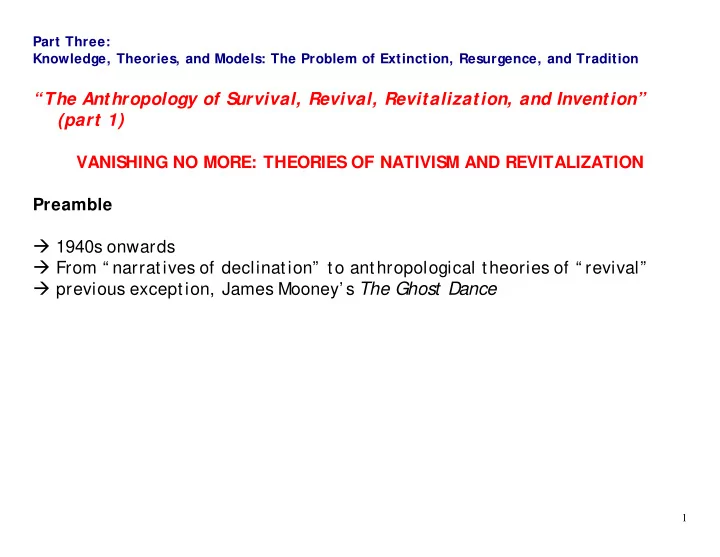

Part Three: Knowledge, Theories, and Models: The Problem of Extinction, Resurgence, and Tradition “The Anthropology of Survival, Revival, Revitalization, and Invention” (part 1) VANISHING NO MORE: THEORIES OF NATIVISM AND REVITALIZATION Preamble � 1940s onwards � From “ narratives of declination” to anthropological theories of “ revival” � previous exception, James Mooney’ s The Ghost Dance 1
Nativist Movements: Linton Linton, Ralph; Redfield, Robert; Herskovits, Melville J. (1935). “Memorandum for the Study of Acculturation.” Man , 35, October, 145-148. http://0- www.jstor.org.mercury.concordia.ca/stable/pdfplus/279 1001.pdf Linton, Ralph. (1943). “Nativistic Movements.” American Anthropologist, 45(2), April-June, 230-240. http://0- www.jstor.org.mercury.concordia.ca/stable/pdfplus/663 272.pdf � Linton, Herskovits, Redfield, a proj ect to describe and analyze “ acculturation” � Linton, et al., 1935, Acculturation : “ those phenomena which result when groups of individuals having different cultures come into continuous first-hand contact with subsequent changes in the original cultural patterns of either or both groups.” 2
� Linton,1935, Reaction : “ where because of oppression, or because of the unforeseen results of the acceptance of foreign traits, contra-acculturative movements arise; these maintaining their psychological force (a) as compensations for an imposed or assumed inferiority, or (b) through the prestige which a return to older pre- acculturative conditions may bring to those participating in such a movement.” � From Reaction to Nativism � Linton, “ nativistic movements” : “ Any conscious, organized attempt on the part of a society’ s members to revive or perpetuate selected aspects of its culture” (1943: 230) � certain current or remembered elements of a culture are selected for emphasis and given symbolic value � consciousness of presence of other cultures + existence of one’ s own culture is seen as threatened 3
� cultural self-consciousness: by-product of close and continuous contact with other societies; a phenomenon of acculturation � 4 types of nativistic movements: � (a) Revivalistic nativistic movement includes in its selection of defining cultural elements some of those which are current in the culture although derived from its past. � (b) Perpetuative nativistic movement may include elements which had been consciously revived at an earlier date . � (c) Magical nativistic movements : role of a messiah, a prophet; supernatural facets; apocalyptic; revival of past traditions, symbols � (d) Rational nativistic movements : remembering a past when members of the society were free, happy. � Can combine types, for example: Rational perpetuative nativistic movements , social solidarity, social perpetuation 4
� Nativistic movements arise from situations of inequality; “ attitudes” of superiority/ inferiority, actual dominance and submission � Nativistic tendencies will be strongest in those classes or individuals who occupy a favored position and who feel this position threatened by culture change. 5
Revitalization Movements: Wallace Wallace, Anthony F. C. (1956). “Revitalization Movements.” American Anthropologist , 58(2), April, 264-281. http://0- www.jstor.org.mercury.concordia.ca/stable/pdfplus/665 488.pdf Wallace, Anthony F. C. (1969). The Death and Rebirth of the Seneca . New York: Random House, Inc. http://books.google.ca/books?id=aiOpKRXS678C&printse c=frontcover&source=gbs_ge_summary_r&cad=0#v=one page&q&f=false Grumet, Robert S. (2003). Anthony F.C. Wallace: Revitalizations and Mazeways— Essays on Culture Change, Vol. 1. http://books.google.ca/books?id=hh1- Q0hvEVsC&printsec=frontcover&source=gbs_ge_summar y_r&cad=0#v=onepage&q&f=false http://books.google.ca/books?id=3_8hTUOXCiwC&prints ec=frontcover#v=onepage&q&f=false 6
� Anthony F.C. Wallace, further developed Linton’ s concepts, from nativism to revitalization � Wallace, 1956, “ revitalization movements,” closely resemble Linton’ s “ magical nativistic movements” � A revitalization movement is: “ a deliberate, organized, conscious effort by members of a society to construct a more satisfying culture” (Wallace 1956: 265). � to innovate a new cultural system , response to situations of stress, conflict and inequality. � Revitalization requires people who: (1) perceive their culture as a system (2) feel that the cultural system is unsatisfactory (3) innovate a new a cultural system as a whole � “ Mazeway ” and lived reality : from conflict to close alignment of the two 7
� Revitalization reduces stress by bringing the mazeway and actual reality into closer correspondence � Wallace’ s “ nativistic movements” : revitalization movements aimed at elimination of alien persons, customs, and values from the mazeway � “ Revivalistic” movements: reintroduction of customs, values, thought to have been in the mazeway of previous generations 8
Reformulating Tradition Thomas, Nicholas. (1992). “The Inversion of Tradition.” American Ethnologist , 19(2) May, 213-232. http://0-www.jstor.org.mercury.concordia.ca/stable/pdfplus/645034.pdf � Nicholas Thomas, Melanesian islands � the “ reform and reformulation ” of tradition: an “ immediate strategy ” for dealing “ both with what is inadequate in intersocial relations and with what seems unsatisfactory or backward in one’ s own situation” (Thomas 1992: 228) � the “ objectification of tradition :” the organization of a “ neotraditional culture ” organized primarily in novel and oppositional terms � certain practices and characteristics of an “ emblematic way of life,” seen as distinctive of a community � neotraditional movements obj ectify their identity and traditions; oppositional naming and categorization 9
� “ Articulation ” , when something already present in a culture becomes explicit or is made explicit in new terms that alter its content and how it is valued 10
The Systematization of Tradition: Sissons Sissons, Jeffrey. (1993). “The Systematisation of Tradition: Maori Culture as a Strategic Resource.” Oceania, 64(2), December, 97-116. http://0-www.jstor.org.mercury.concordia.ca/stable/pdfplus/40331380.pdf � S tates, incorporating Indigenous partners, codify Indigenous traditions � Traditions become rationalized and organized � the nationalization of ethnicity New Zealand Ministry for Culture and Heritage http://www.mch.govt.nz/ New Zealand High Commission Ottawa, Canada: About New Zealand http://www.nzembassy.com/canada/going-new-zealand/about-new-zealand Air New Zealand http://www.airnewzealand.ca/gateway New Zealand Government http://newzealand.govt.nz/ Department of Maori Affairs (Ministry of Maori Development) http://www.tpk.govt.nz/en/ 11
� community-based decision-making � “ nurturing” cultural development � encouraging the development and use of marae , traditional social and ritual centres � building harmonious relationships and a national identity (Dept. of Education 1985) � the state, and the Maori population, were partners � In 1987 a Maori Language Act: Maori as an official language. 12
Conceptualizing Resurgence (a) Objectification (b) Politicization and organization (c) Revaluation (d) Increased recognition 13
Recommend
More recommend